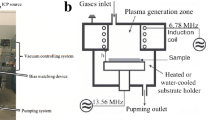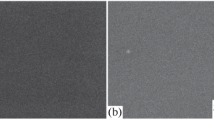Abstract
In plasma devices, in which plasma–wall interaction and material migration are significant, the diagnostic-window transmission may decrease due to the contamination of plasma-cleaning components by sputtered materials. We discuss the cleaning of KU-1 fused silica, which simulates the diagnostic window, from aluminum films in RF plasma generated in pure H2(D2) and Ne and in H2(D2)–0.23Ne mixtures. Aluminum is used as a chemical analogue of Be, which is the main material of the International Thermonuclear Experimental Reactor (ITER) first wall. The morphology of the plasma-treated surface is investigated by atomic force microscopy, the chemical composition is analyzed by X-ray photoelectron spectroscopy, and the transmission spectra in the range 400−1000 nm shows that plasma cleaning is accompanied by the slight reduction of quartz to suboxides and a simultaneous decrease in roughness Rq from 1.3 up to 1.0 nm. After plasma treatment of the quartz surface, a decrease in light transmission by 1.5–2% in the wavelength range 400–750 nm is observed. Further sputtering of the purified quartz surface with the removal of a layer with a thickness of more than 300 nm is accompanied by gradual smoothing of the surface and a decrease in Rq to 1 nm, but with the retention of reduced light transmission. All investigated gases, hydrogen isotopes, neon and D2(H2)–Ne mixtures, are suitable for removing Al films from the quartz surface at a RF power of several W/cm2 and temperatures of 20–100°C.









Similar content being viewed by others
REFERENCES
ITER Technical Basis, IAEA/ITER EDA/DS/24 (Int. At. Energy Agency, Vienna, 2002), p. 816.
T. Hirai, S. Panayotis, V. Barabash, et al., Nucl. Mater. Energy 9, 616622 (2016). https://doi.org/10.1016/j.nme.2016.07.003
G. J. Van Rooij, J. W. Coenen, L. Aho-Mantila, et al., J. Nucl. Mater. 438, 42 (2013).
A. Kallenbach, M. Bernet, R. Dux, et al., Plasma Phys. Controlled Fusion 55, 124041 (2013).
E. E. Mukhin, G. S. Kurskiev, A. V. Gorbunov, et al., Nucl. Fusion 59, 086052 (2019). https://doi.org/10.1088/1741-4326/ab/cd5
P. Shigin, N. Babinov, G. De Temmerman, A. Danisi, et al., Fusion Eng. Des. 164, 112162 (2021).
D. V. Orlinski and V. T. Gritsyna, Probl. At. Sci. Technol., Ser.: Plasma Phys., No. 3, 60 (2000).
S. Veprek, C. Wang, and M. G. J. Veprek-Heijman, J. Vac. Sci. Technol., A 26, 313 (2008).
L. Marot, C. Linsmeier, B. Eren, L. Moser, R. Steiner, and E. Meyer, Fusion Eng. Des. 88, 1718 (2013).
A. E. Gorodetsky, V. L. Bukhovets, A. V. Markin, V. I. Zolotarevskii, R. Kh. Zalavutdinov, N. A. Babinov, A. M. Dmitriev, A. G. Razdobarin, and E. E. Mukhin, Tech. Phys. 66, 288 (2021). https://doi.org/10.1134/S1063784221020122
F. J. Grunthaner, B. F. Lewis, and N. Zamini, IEEE Trans. Nucl. Sci. NS-27, 1640 (1980).
A. E. Gorodetsky, V. L. Bukhovets, A. V. Markin, V. I. Zolotarevsky, R. Kh. Zalavutdinov, E. E. Mukhin, and A. G. Razdobarin, J. Surf. Invest.: X-ray, Synchrotron Neutron Tech. 15, 660 (2021). https://doi.org/10.1134/S1027451021040054
L. J. Zeng, T. Greibe, S. Nik, C. M. Wilson, P. Delsing, and E. Olsson, J. Appl. Phys. 113, 143905 (2013). https://doi.org/10.1063/1.4801798
J. E. Harvey, S. Schroder, N. Choi, and A. Duparre, Opt. Eng. 519, 013402 (2012).
R. N. Pfisterer, Opt. Photonics News, No. 10, 16 (2011).
V. I. Vedeneev, L. V. Gurvich, V. N. Kondrat’ev, V. A. Medvedev, and E. L. Frankevich, Energy of Chemical Bond (Akad. Nauk SSSR, Moscow, 1962) [in Russian].
D. D. Wagman, W. H. Evans, V. S. Parker, R. H. Schumm, I. Halow, S. M. Bailey, K. L. Churley, and R. L. Nuttall, J. Phys. Chem. Ref. Data 11 (2 suppl.), 2 (1982).
L. T. Zhuravlev, Colloids and Surfaces, A 173, 1 (2000). https://doi.org/10.1016/S0927-7757(00)00556-2
G. Hass and C. D. Salzberg, J. Opt. Soc. Am. 44, 181 (1954).
E. Centurioni, Appl. Opt. 44, 7532 (2005).
Author information
Authors and Affiliations
Corresponding authors
Rights and permissions
About this article
Cite this article
Gorodetsky, A.E., Markin, A.V., Bukhovets, V.L. et al. Light Transmission and Surface Topography of KU-1 Optical Quartz After Sputtering and Cleaning from Al Films in RF Discharge of H2(D2)–Ne Mixtures. J. Surf. Investig. 15, 1029–1038 (2021). https://doi.org/10.1134/S102745102105027X
Received:
Revised:
Accepted:
Published:
Issue Date:
DOI: https://doi.org/10.1134/S102745102105027X




